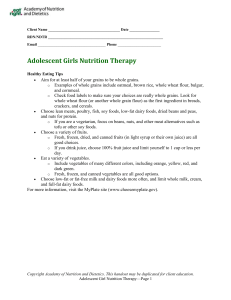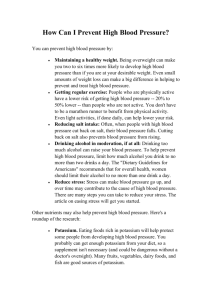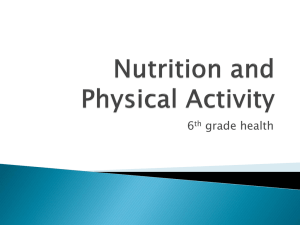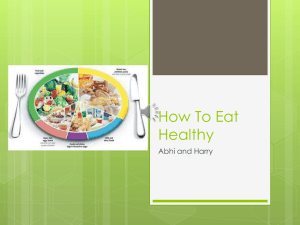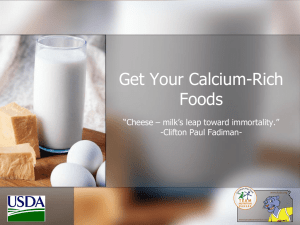Document 11075680
advertisement
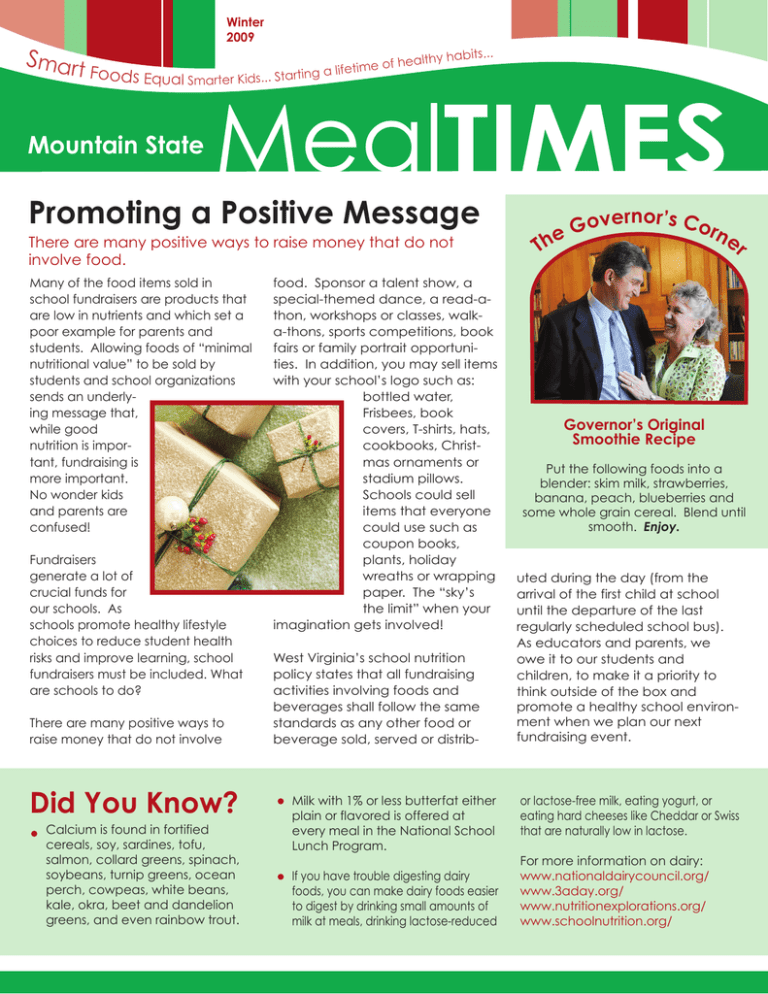
Smart Winter 2009 Foods f lifetime o Equal Smarter Kids... Starting a Mountain State abits... healthy h MealTIMES Promoting a Positive Message There are many positive ways to raise money that do not involve food. Many of the food items sold in school fundraisers are products that are low in nutrients and which set a poor example for parents and students. Allowing foods of “minimal nutritional value” to be sold by students and school organizations sends an underlying message that, while good nutrition is important, fundraising is more important. No wonder kids and parents are confused! Fundraisers generate a lot of crucial funds for our schools. As schools promote healthy lifestyle choices to reduce student health risks and improve learning, school fundraisers must be included. What are schools to do? There are many positive ways to raise money that do not involve Did You Know? Calcium is found in fortified cereals, soy, sardines, tofu, salmon, collard greens, spinach, soybeans, turnip greens, ocean perch, cowpeas, white beans, kale, okra, beet and dandelion greens, and even rainbow trout. food. Sponsor a talent show, a special-themed dance, a read-athon, workshops or classes, walka-thons, sports competitions, book fairs or family portrait opportunities. In addition, you may sell items with your school’s logo such as: bottled water, Frisbees, book covers, T-shirts, hats, cookbooks, Christmas ornaments or stadium pillows. Schools could sell items that everyone could use such as coupon books, plants, holiday wreaths or wrapping paper. The “sky’s the limit” when your imagination gets involved! West Virginia’s school nutrition policy states that all fundraising activities involving foods and beverages shall follow the same standards as any other food or beverage sold, served or distrib- Milk with 1% or less butterfat either plain or flavored is offered at every meal in the National School Lunch Program. If you have trouble digesting dairy foods, you can make dairy foods easier to digest by drinking small amounts of milk at meals, drinking lactose-reduced overnor’s Cor G ne e r Th Governor’s Original Smoothie Recipe Put the following foods into a blender: skim milk, strawberries, banana, peach, blueberries and some whole grain cereal. Blend until smooth. Enjoy. uted during the day (from the arrival of the first child at school until the departure of the last regularly scheduled school bus). As educators and parents, we owe it to our students and children, to make it a priority to think outside of the box and promote a healthy school environment when we plan our next fundraising event. or lactose-free milk, eating yogurt, or eating hard cheeses like Cheddar or Swiss that are naturally low in lactose. For more information on dairy: www.nationaldairycouncil.org/ www.3aday.org/ www.nutritionexplorations.org/ www.schoolnutrition.org/ Mountain State MealTIMES Banana Yogurt Shake Bone Up with Calcium According to the United States Department of Agriculture, 8 out of 10 teenage girls and 6 out of 10 teenage boys do not get enough calcium. Children ages nine to eighteen (the peak bone building years) require a daily calcium intake of 1,300 milligrams. Dairy foods are the best source of calcium, and children who eat dairy foods have stronger bones and better overall health. When children habitually drink sodas or other sweetened drinks, and even water, in place of milk, they’re often not receiving the necessary calcium requirement of three servings a day. When this happens, children run the risk of fractures and of developing osteoporosis (crippling bone disease) later in life. Good habits start early, and eating calcium-rich foods, in addition to regular physical activity, is an important way for the whole family to build stronger bones. Nutrients in dairy foods include calcium, magnesium, phosphorus, potassium, protein and vitamin D. These nutrients work together to help build and protect bones. The Dietary Guidelines for Americans recommends three servings of low-fat or fat-free dairy foods a day for everyone ages 2 years and older. A serving of dairy is 1 cup (8 ounces) milk or yogurt, 1.5 ounces of low-fat, fat-free, or reduced fat natural cheese or 2 ounces of low-fat or fat-free processed cheese. Try these easy tips to increase the taste and flavor of calcium-rich products in your diet: • • • • • • 1 1/2 cups fat-free milk 4 small bananas, peeled 1 cup low-fat, plain yogurt 1 teaspoon vanilla 1/2 teaspoon cinnamon 1/8 teaspoon nutmeg 1 cup ice cubes Combine all ingredients except ice cubes in blender or food processor; process until thick and creamy. With motor running, add ice cubes; process until smooth. Pour into tall glasses to serve. Yields 4 servings (1/2 cup per person). Nutritional information: 160 calories; fat 2 g; trans fat 0; sodium 85 mg; carbohydrates 32 g; dietary fiber 3 g; sugars 21 g; protein 7 g; contains vitamins A and C, calcium and iron. combine 1 cup of low-fat milk or yogurt, fruit and ice cubes in a blender for a delicious smoothie; top pancakes with yogurt and fruit instead of syrup; add freshly shredded Mozzarella or Monterey Jack cheese to salads; serve low-fat or fat-free flavored yogurt as a dip for cut up fruit; mix 1 cup of plain yogurt with mustard or ranch dressing for dipping pretzels and vegetables; heat a cup of low-fat or fat-free chocolate milk for an afternoon break; skewer a banana, dip it in low-fat yogurt and then coat with cereal or granola. WV School Wellness Success Story: Clay County Middle School ring, Comm Ca ent, and Su lunch in the middle and high schools on Chef itm Larry’s message board. Monthly Calendars with nutrition messages and the menus for breakfast and lunch are sent home. The local television station, WCHS-Channel 8, announces the daily menus. Daily County menus are publicized on the Counties internet site: http://www.claycountyschools.org . e ss cc Clay County Middle School has participated in every Team Nutrition Training Grant since 1996. The school has the support of their students, staff, parents and business community partners in helping promote a healthy nutrition and physical activity environment. The food service personnel promote a positive message by advertising the daily menu for breakfast and 1900 Kanawha Boulevard, East Building 6, Room 248 Charleston, West Virginia 25305-0330 Phone: 304-558-2708 Fax: 304-558-1149 http://wvde.state.wv.us/nutrition/ This project has been funded at least in part with Federal funds from the US Department of Agriculture. The contents of this publication do not necessarily reflect the view or policy of the US Department of Agriculture, nor does mention of trade names, commercial products, or organizations imply endorsement from the US government. This institution is an equal opportunity provider.
